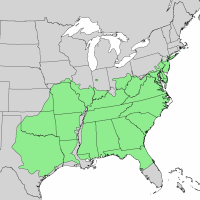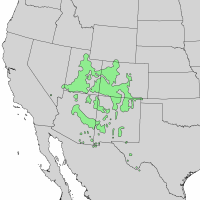
About Oaks (home) | Map | Plant List | Cultivar/Species Information | Sources | Other Campus Oaks of Interest
Latin Name: Quercus macrocarpa [Relict]
Common Name: Relict* Bur Oak
![Quercus macrocarpa [Relict]](image/OAKS/MACROCARPARELICT/RELICT%20LOCATION%20MAP_0.png)
Cultivar: Relict is not a registered cultivar name, nor a registered trademark name, but trees grown from Burr Oak Canyon acorns are sold under that name.
Family: Fagaceae
Division: White
Native range: Burr Oak Canyon, southwest Nebraska
Introduced:
Sun/Shade: Sun
Height × Width: 70' - 80' × equal or greater, in the wild
Form: Pyramidal when young; oval, broad, even open, with age
Zones: 3 - 8
Flower: Monoecious. Pistillate catkins (male inflorescence).
Leaves: Widely varied
Fall Color: dull yellow, yellow-brown.
Fruit: Nut. Varied.
Buds: Sharp and pointed or blunt, pale pubesence.
Bark: rough, deeply-furrowed and ridged, dark gray – gray-brown
Disease issues: None serious
Where to find Quercus macrocarpa [Relict] in Maxwell Arboretum:![Quercus macrocarpa [Relict] location map](image/OAKS/MACROCARPA_RELICT/Macrocarpa%20Relict%20location%20map_0.png)
Notes: *relict: "A relict (or relic) plant or animal is a taxon that persists as a remnant of what was once a diverse and widespread population. Relictualism occurs when a widespread habitat or range changes and a small area becomes cut off from the whole. A subset of the population is then confined to the available hospitable area, and survives there while the broader population either shrinks or evolves divergently.
This phenomenon differs from endemism in that the range of the population was not always restricted to the local region. In other words, the species or group did not necessarily arise in that small area, but rather was stranded, or insularized, by changes over time. The agent of change could be anything from competition from other organisms, continental drift, or climate change such as an ice age." (Wikipedia)
Justin Evertson on Relict Bur Oaks and Burr Oak Canyon:
"As its name implies, Burr Oak Canyon, near the Kansas border in SE Hitchcock County, is named for the oaks that grow there (the earlier name Burr Oak is used in this context). This disjunct stand of trees grows at least 50 miles from the nearest native stands of oaks, begging the question, how did they get there? It’s doubtful that squirrels or other creatures were able to carry the acorns that far. Most likely, the trees were stranded in the canyon by a changing climate. About 10,000 years ago, as the last Ice Age glaciers retreated, oaks and other trees were able to move rapidly north, giving Nebraska a much more forested ecosystem. Then about 5,000 years ago, the climate became hotter and drier, favoring grasslands and causing many trees to disappear. It’s likely that the trees in Burr Oak Canyon have been hanging on in this protected and slightly wetter ravine for thousands of years.
Burr Oak canyon also tells the story of other oak species that likely grew in the area eons ago. Several of the oaks show hybrid characteristics in leaf shape and acorns of both post oak (Quercus stellata) and gambel oak (Quercus gambelii). Post oak is now a southern Great Plains native while gambel oak is a Rocky Mountain species. At one time, all three oaks likely grew together in southwest Nebraska, sharing genes and creating these interesting hybrids."
________________________
Over the years, people and publications have referenced the canyon's oaks' morphological features resembling those of Post Oak and Gambel Oak, but as of this writing, no DNA sequencing analysis has been conducted. Awaiting a grad student in need of a project. . .


Current range of Quercus stellata. Current range of Quercus gambelii.
_____________________
Where did Maxwell Arboretum's (and the other so-called Relict Bur Oaks on campus) come from? They were planted by Agronomy and Horticulture Prof. Kim Todd and her students as part of "150 for 150", 150 trees planted in 2019, the 150th annivarsary of the founding of the Univeristy of Nebraska.
Todd got the trees from Heather and Brian Byers, owners of Great Plains Nursery near Weston, NE, who collected their acorns at Burr Oak Canyon.
__________________________________________
- See photos of the canyon and read about the 2019 Burr Oak Canyon Symposium.
- 2008 Symposium.
- And some nice pics from the canyon by 2019 symposium participants
See Dicke and Bagley, Silvae genetica 29:171-196 (1980).
Walter Bagley of the Nebraska Forest Service says he has seen acorn involucre not fringed. (Dirr.)
______________________________________
←Previous Oak → NEXT OAK
All photographs from Earl G. Maxwell Arboretum unless otherwise noted.
Foliage
(Exhibits a bit of herbicide damage)
More images coming soon.
Some pretty steeply cut terrain for Nebraska:
